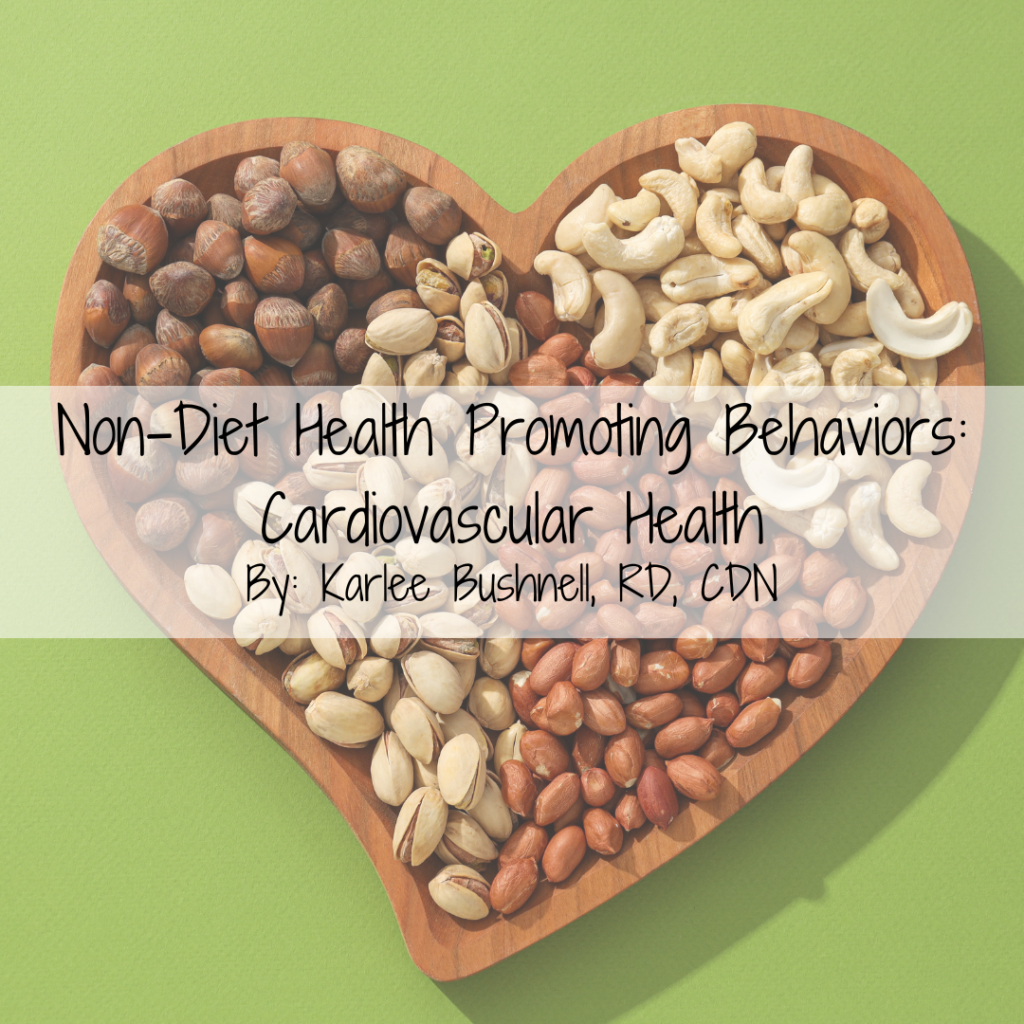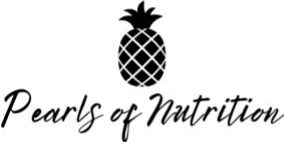
Non-Diet Health Promoting Behaviors: Cardiovascular Health
February is American Heart Month and with that can come increased messaging around guidance that is “heart healthy”. While these recommendations are not all inherently bad, oftentimes they are more weight-focused instead of focusing on health promoting behaviors for folks in all body sizes through a more Intuitive Eating (IE) and Health at Every Size (HAES) framework. Having anti-diet and non-weight focused goals can feel like a more compassionate way to show love to our hearts!
Heart disease, or cardiovascular disease (CVD), encompasses various conditions affecting the heart and blood vessels, including coronary artery disease, heart attacks, and heart failure. Major risk factors include high blood pressure, elevated cholesterol levels, smoking, and a less physically active lifestyle. It’s important to know that increasing health promoting behaviors without a focus on weight loss can help to mitigate these risk factors. A study in the Journal of Nutrition Education and Behavior demonstrated that IE is associated with improved biomarkers related to cardiovascular health, such as lower triglyceride levels and a healthier balance between low-density and high-density lipoproteins, “and could be a viable target for interventions to help decrease the risk of cardiovascular disease among older adults”.
Within the IE framework, the 10th Principle of “Honor Your Health – Gentle Nutrition” focuses on making food choices that honor your health and taste buds while making you feel your best. Incorporating a variety of nutrient-dense foods can support heart health without the need for restrictive dieting. So what are some specific nutrients that can positively impact our tickers?
Fiber: Dietary fiber, particularly soluble fiber, helps lower cholesterol levels by binding to cholesterol particles in the digestive system and removing them from the body. This process reduces the risk of plaque buildup in the arteries, thereby decreasing the likelihood of heart disease. Foods rich in fiber include legumes, whole grains, fruits, and vegetables.
Omega-3 fatty acids: Omega-3 fatty acids are essential fats that the body cannot produce on its own. They have been shown to reduce inflammation, lower blood pressure, and decrease triglyceride levels, all of which are risk factors for CVD. Fatty fish like salmon, mackerel, and sardines are excellent sources of omega-3s. Plant-based sources include flaxseeds, chia seeds, and walnuts.
Antioxidants: Antioxidants protect the heart by neutralizing free radicals, which can cause oxidative stress and damage to blood vessels. This protection helps prevent the development of atherosclerosis, a condition characterized by the hardening and narrowing of the arteries. Foods high in antioxidants include berries, dark chocolate, nuts, and leafy green vegetables.
Another fun fact when thinking about food that benefits our cardiovascular health is that a few foods that resemble the heart are beneficial for heart health (and can make it easier to remember!). These include: beets; red fruits such as strawberries, raspberries, apples and cherries; tomatoes; red peppers.
Complete meal ideas to incorporate these nutrients:
- Oatmeal with Berries and Nuts/Seeds: Start your day with a bowl of oatmeal topped with berries of your choice (frozen can be a more cost-effective, nutrient dense option, especially in the winter), walnuts and chia seeds. Oats are rich in soluble fiber, which can help to lower cholesterol levels, nuts/seeds provide healthy fats and some fiber beneficial for heart health, while the berries provide antioxidants and another hit of fiber.
- Grilled Salmon with Sweet Potatoes and Roasted Vegetables: Enjoy a serving of grilled salmon, a source of omega-3 fatty acids, paired with a sweet potato and a medley of your favorite roasted vegetables like red bell peppers and kale for a fiber and antioxidant boost.
- Whole Grain Black Bean Quesadilla: Using a whole grain tortilla, make a black bean and spinach quesadilla that is rich in fiber from the beans and whole grains as well as antioxidants from the spinach. Top with pico de gallo for extra fiber, antioxidants, and flavor.
Snack Ideas:
- Snack Plate: For a more sweet version, serve an apple with dark chocolate (look for 70% cocoa or higher), pecans, and pumpkin seeds. If you prefer more of a savory snack plate, try combining pickled beets, bell peppers with a dip of your choice such as hummus or a lentil dip and whole grain crackers.
- Smoked Salmon Bites: Cut cucumber slices, top with smoked salmon, mashed avocado, and a sprinkle of flaxseeds (also very good topped with everything bagel seasoning!).
- Energy Balls: Combine oats, ground flaxseeds, nut butter, unsweetened coconut flakes and dark chocolate chips. Roll into bite-sized balls and refrigerate.
Moreover, enhancing heart health extends beyond dietary choices, encompassing various lifestyle factors that contribute to cardiovascular well-being. Integrating joyful movement, effective stress management, and fostering social connections are pivotal in reducing the risk of heart disease.
Movement:
Engaging in movement is helpful for maintaining/bettering cardiovascular health. Exercise helps lower blood pressure, improve cholesterol levels, and enhance overall heart function. The American Heart Association (AHA) recommends “at least 150 minutes per week of moderate-intensity aerobic activity or 75 minutes per week of vigorous aerobic activity, or a combination of both, preferably spread throughout the week”, as well as two days of resistance or weight training. Movement is also part of the IE framework, and can be found more in the 9th Principle, titled “Movement—Feel the Difference”, which encourages individuals to “shift your focus to how it feels to move your body, rather than the calorie-burning effect of exercise. If you focus on how you feel from working out, such as energized, it can make the difference between rolling out of bed for a brisk morning walk or hitting the snooze alarm”.
If just getting started by incorporating more movement into your day, even just working to be less sedentary has been shown to be beneficial. Some ideas on how to incorporate more natural movement throughout your day can be found in this blog post, by my colleague, Nina Rosien who is a Registered Dietitian and Certified Personal Trainer. Start slow with things like walking, doing more housework or a seated yoga/stretching routine that meets you where you are at. Next, attempt to find what forms of movement feel joyful for you – perhaps it’s joining a pickleball league, rock climbing or hiking? You can also try to add in things to make movement more enjoyable such as listening to music, an audiobook or favorite podcast or asking a loved one to join you. Please note, if you have any physical limitations, please speak with your healthcare providers about safe and appropriate ways to begin to include movement.
Stress Management:
Chronic stress has been shown to negatively impact mental and physical health, as well as increase the likelihood of someone engaging in unhealthy lifestyle behaviors such as smoking, not taking medications as directed or not incorporating movement. Per the AHA, more research is needed to learn more about how stress contributes to CVD and stroke, however it is known that negative psychological and mental health is associated with an increased risk of heart disease and stroke. Trying to have healthy coping mechanisms to navigate stress in our lives can be important. Speak with your healthcare team, including your RD, about coming up with a list of positive coping strategies you can utilize to try to ward off chronic stress.
Social Connections
High-quality relationships can help folks to live longer, healthier lives. Social connections can help to reduce the risk of chronic diseases such as CVD and stroke, as well as help to manage stress. Overall, staying connected to others creates feelings of belonging and being loved, cared for, supported, and valued. If you are looking for ways to increase your social engagements, look for groups or organizations of things you are interested in – perhaps it’s joining a book club, volunteering or just asking a friend if they have any mutual friends they think you would get along with?
To wrap things up, I hope this post serves as a gentle reminder that looking to improve your heart health does not have to be steeped in diet culture or focused on as a way to lose weight. There are plenty of non-diet, non weight-focused ways to ameliorate your cardiovascular health, just in time for American Heart Month (plus Valentine’s Day – and what better way to show ourselves some love and care than taking care of our physical and mental health?).
Sources:
Teas E, Kimiecik J, Ward RM, Timmerman K. Intuitive Eating and Biomarkers Related to Cardiovascular Disease in Older Adults. J Nutr Educ Behav. 2022;54(5):412-421. doi:10.1016/j.jneb.2022.01.010
https://www.health.harvard.edu/heart-health/sizing-up-superfoods-for-heart-health
https://www.cdc.gov/social-connectedness/about/index.html
https://www.slu.edu/news/2017/february/heart-shaped-healthy-foods.php
https://www.intuitiveeating.org/about-us/10-principles-of-intuitive-eating/
https://www.heart.org/en/healthy-living/healthy-lifestyle/stress-management/stress-and-heart-health


